For many dog lovers, the joy of pet ownership comes with a hidden challenge: allergies. The dream of a furry companion can quickly turn into a sneezy, itchy reality due to pet dander. This is where the appeal of low-shedding or “hypoallergenic” dog breeds comes in, offering a glimmer of hope for allergy sufferers. While no dog is entirely allergen-free, certain breeds produce significantly less dander and shed minimally, making them far more compatible for individuals with sensitivities.
At Dog Care Story, we understand the desire for a loving canine companion without the constant worry of allergic reactions. This guide delves into the world of best house dog breeds that don’t shed, exploring what makes them suitable for allergy-friendly homes and providing a detailed look at 30 remarkable breeds that can bring joy and companionship into your life with fewer sniffles.
Understanding “Hypoallergenic” vs. “Low-Shedding” Dogs
The term “hypoallergenic” is often used to describe dogs that are less likely to cause allergic reactions. However, it’s crucial to understand that no dog is 100% allergen-free. Allergens are found not only in a dog’s hair but also in their dander (flakes of dead skin), saliva, and urine. These allergens can trigger responses like coughing, itching, or wheezing in sensitive individuals.
Dogs labeled “hypoallergenic” are typically those that shed very little, meaning they release less hair and dander into the environment. Their coats often trap dander, preventing it from becoming airborne. This reduction in airborne allergens is what makes them a better fit for people with allergies. Consistent grooming and a clean living environment are still essential to manage any remaining allergens.
Best House Dog Breeds That Don’t Shed (and Why They’re Great for Allergy Sufferers)
While a truly allergen-free dog remains a myth, there’s a wide selection of breeds that are known for their low-shedding coats, making them excellent choices for indoor living and individuals sensitive to dander. Here are some of the most popular and suitable house dog breeds that don’t shed much:
1. Poodle
 White Poodle walking through lush green grass on a sunny day
White Poodle walking through lush green grass on a sunny day
Poodles come in three sizes—Standard, Miniature, and Toy—each renowned for their intelligence and distinctive curly coat. These elegant dogs shed very little, as their tight curls trap loose hair and dander. Originally bred for hunting, Standard Poodles are the largest, while their Miniature and Toy counterparts offer a smaller presence. Regardless of size, consistent grooming is vital to prevent their dense, curly fur from matting. Their low-shedding nature, combined with their sharp minds, makes them a highly adaptable and popular choice for many homes.
2. Yorkshire Terrier
 Blue and tan Yorkshire Terrier lounging comfortably on an armchair indoors
Blue and tan Yorkshire Terrier lounging comfortably on an armchair indoors
Yorkshire Terriers, affectionately known as Yorkies, are delightful small house dog breeds that don’t shed. Their fine, silky hair is more akin to human hair than typical dog fur, which minimizes shedding and dander. Yorkies boast spirited yet affectionate personalities, thriving on family attention. Their compact size allows them to adapt seamlessly to various living situations, from spacious houses to cozy apartments, as long as they receive ample love and interaction.
3. Shih Tzu
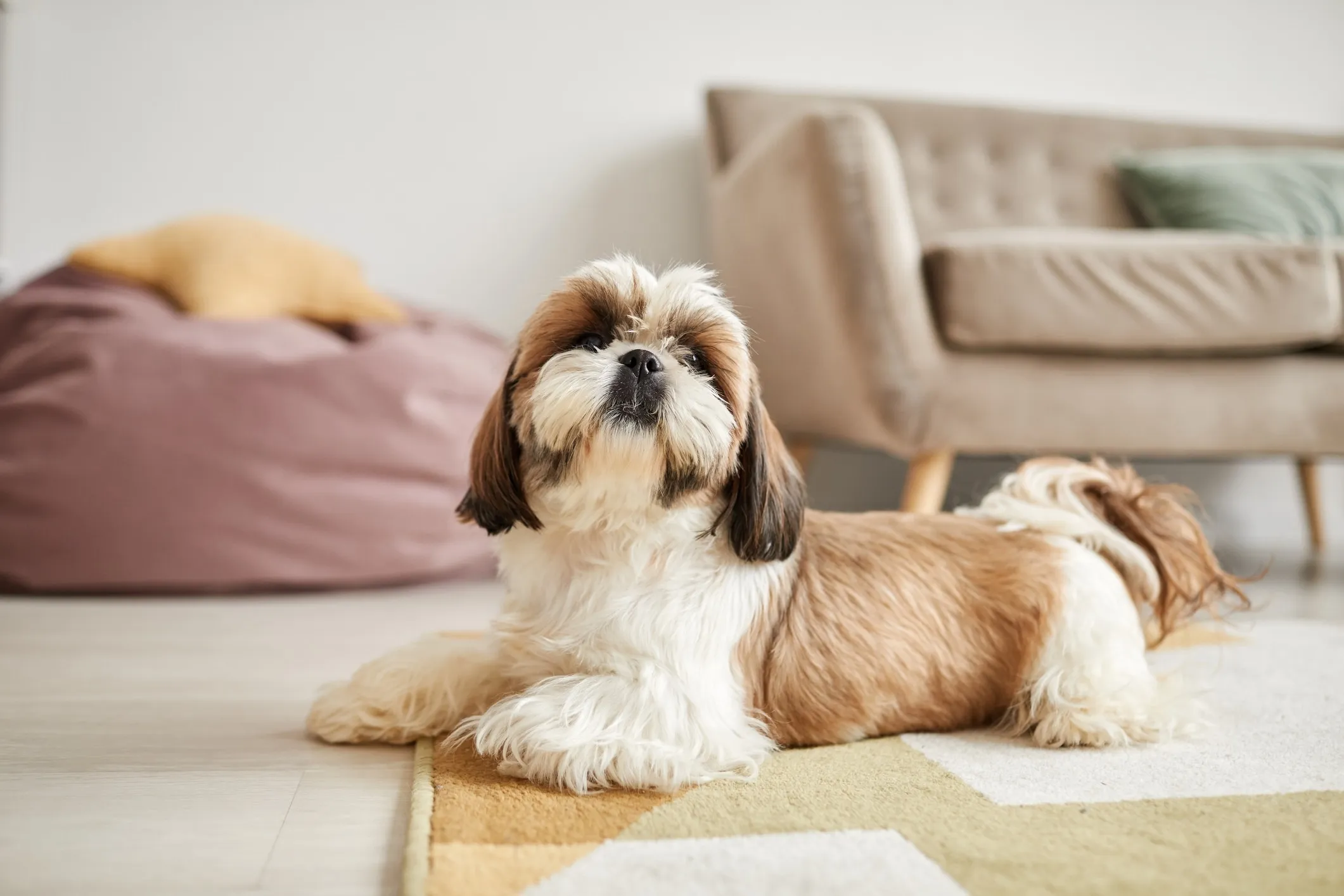 Brown and white Shih Tzu relaxing on a living room floor, looking calm and friendly
Brown and white Shih Tzu relaxing on a living room floor, looking calm and friendly
The Shih Tzu is an ancient companion breed with a characteristic long, flowing double coat that is surprisingly low-shedding. Their friendly and outgoing temperament makes them excellent family pets. However, their brachycephalic (flat) face can predispose them to certain health concerns, including respiratory issues, overheating, and tear stains. Regular eye cleaning can help manage tear staining, ensuring these charming dogs remain comfortable and healthy.
4. Miniature Schnauzer
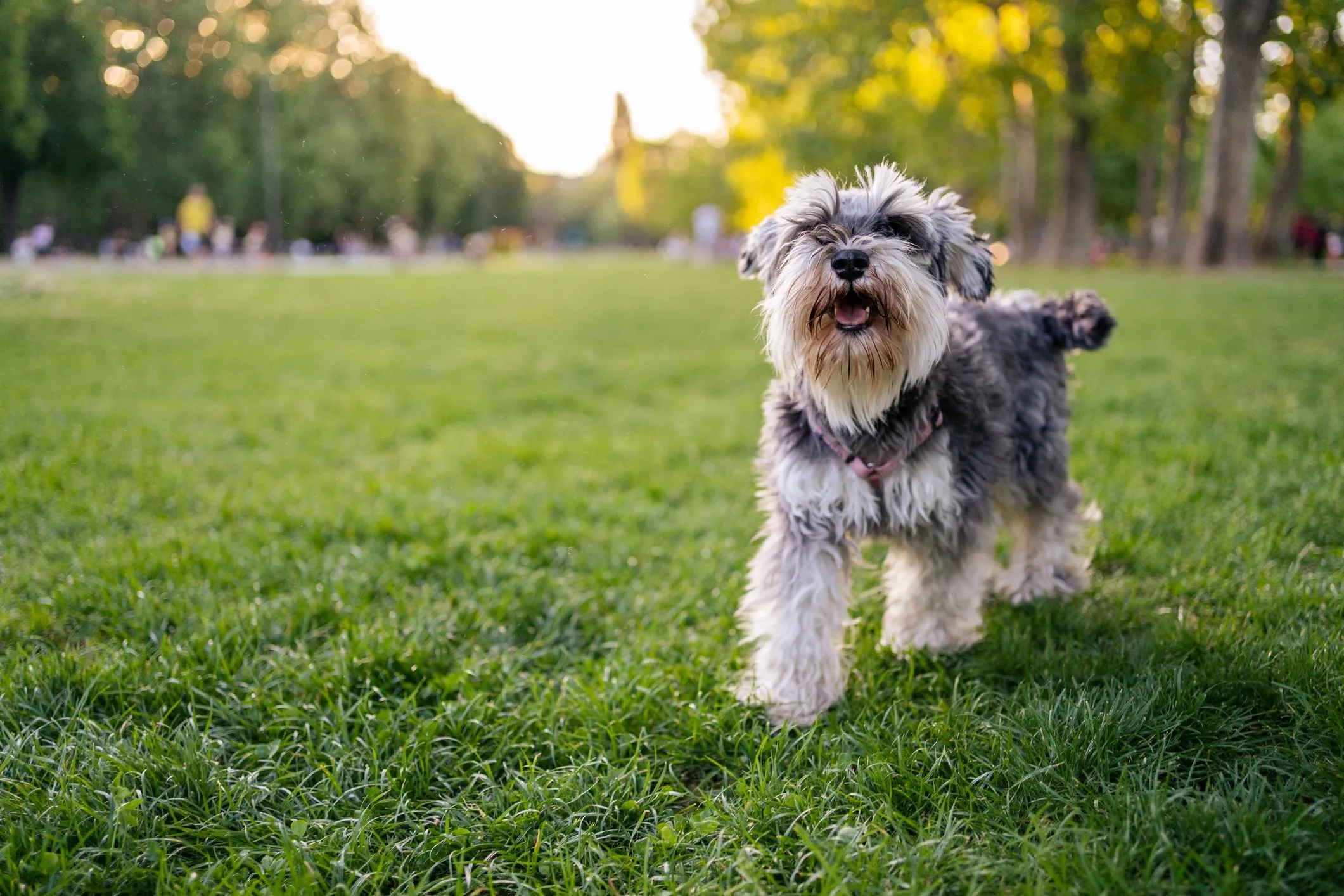 Salt and pepper Miniature Schnauzer wearing a pink harness, standing attentively in a park
Salt and pepper Miniature Schnauzer wearing a pink harness, standing attentively in a park
Among the three Schnauzer breeds, the Miniature Schnauzer is the smallest, typically standing no more than 14 inches tall and weighing 10–20 pounds. Their wiry topcoat and soft undercoat shed minimally. These intelligent dogs are quite adaptable to diverse living environments, provided they receive at least an hour of daily exercise to channel their energetic spirits. Their alert nature and sturdy build make them fantastic companions.
5. Standard Schnauzer
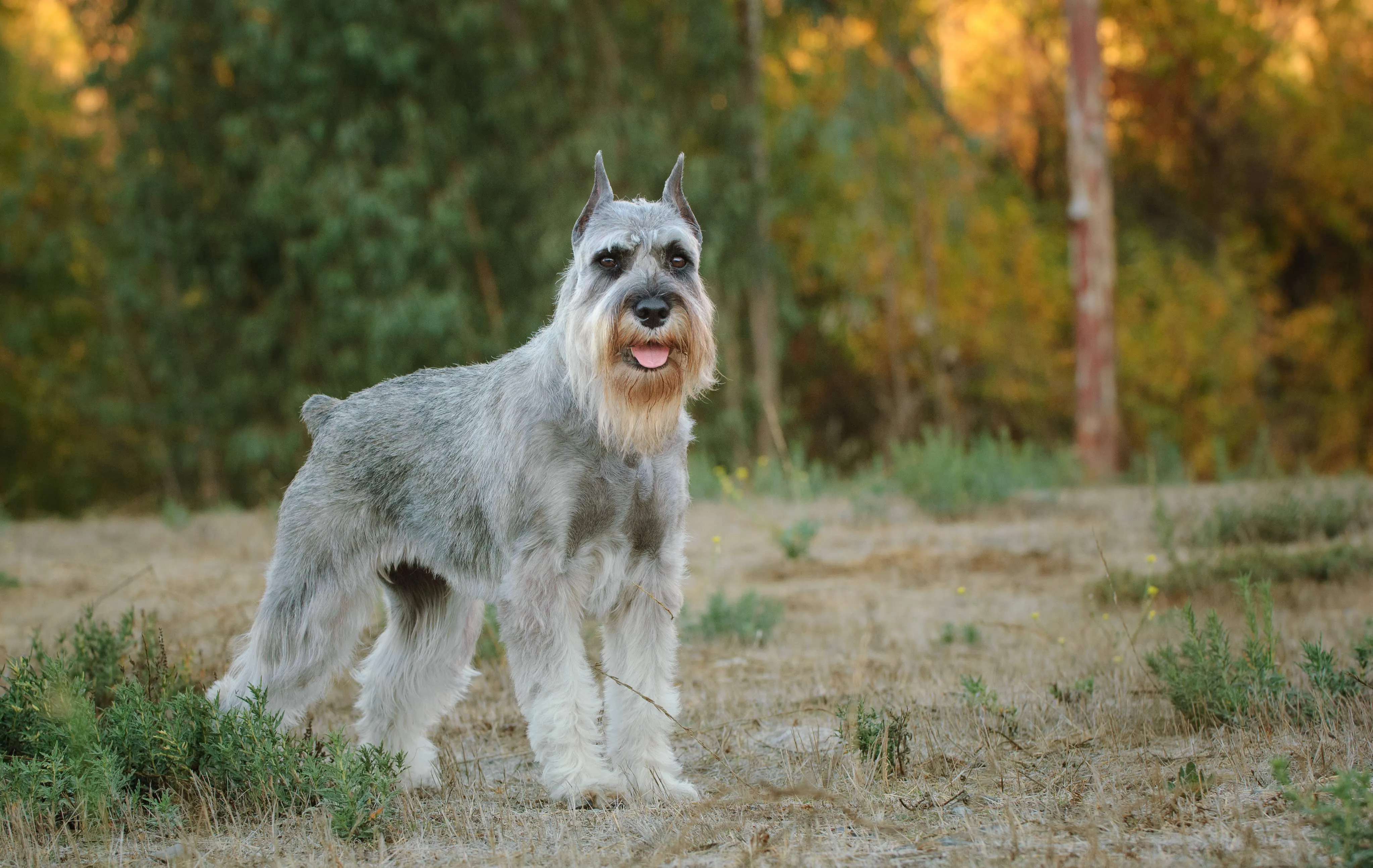 Gray Standard Schnauzer standing alertly in a grassy field under natural light
Gray Standard Schnauzer standing alertly in a grassy field under natural light
The Standard Schnauzer shares many appealing traits with its miniature counterpart but in a larger frame, weighing up to 45 pounds. They possess a similar low-shedding, wiry coat that requires regular grooming. These robust dogs thrive on activity, enjoying long walks, games of fetch, and engaging puzzle toys that stimulate their bright minds. Their loyalty and protective instincts make them excellent family guardians.
6. Giant Schnauzer
 Black Giant Schnauzer with a blue bow collar, wet from water, standing in a park setting
Black Giant Schnauzer with a blue bow collar, wet from water, standing in a park setting
As the largest of the Schnauzer breeds, Giant Schnauzers can reach over 27 inches in height and weigh up to 85 pounds. Despite their size, they are considered low-shedding, making them suitable for some allergy sufferers. These powerful dogs demand substantial exercise to remain happy and well-behaved, including extensive walks, runs, and hikes. Engaging them in vigorous games of fetch with tools like a ball launcher can help meet their high energy requirements.
7. Bichon Frise
 White Bichon Frise dog looking upwards in a grassy area, showcasing its fluffy coat
White Bichon Frise dog looking upwards in a grassy area, showcasing its fluffy coat
The Bichon Frise is a charming, small dog known for its playful and affectionate demeanor and its distinctive curly, “powder puff” coat. This coat is low-shedding, with loose hairs tending to get caught within its dense curls rather than falling out. Highly intelligent and eager to please, Bichons respond well to positive reinforcement training and love to learn new tricks, bringing endless entertainment to their families.
8. Chinese Crested
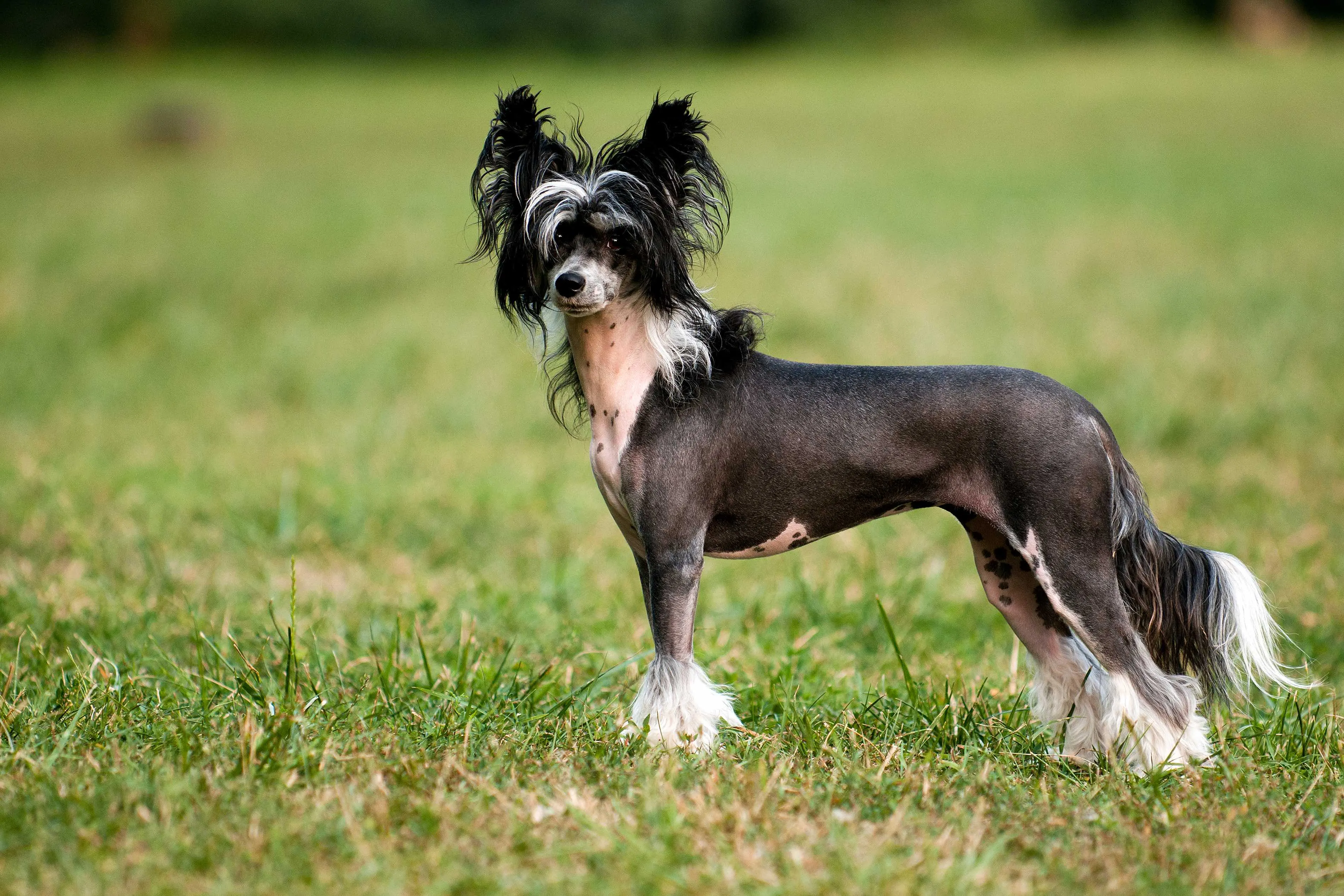 Black hairless Chinese Crested dog looking directly at the camera with an inquisitive expression
Black hairless Chinese Crested dog looking directly at the camera with an inquisitive expression
The Chinese Crested is a truly unique breed known for its striking appearance. It comes in two varieties: the Hairless, with smooth skin and tufts of hair on its head, tail, and paws, and the Powderpuff, which has a full, silky coat. Both varieties are considered low-shedding. These playful and affectionate dogs make wonderful companions, offering a distinct charm to their owners.
9. Portuguese Water Dog
 Black and white Portuguese Water Dog wearing a red maple leaf bandana, standing near water
Black and white Portuguese Water Dog wearing a red maple leaf bandana, standing near water
Originally bred to assist fishermen in Portugal, the Portuguese Water Dog is a robust, medium-sized breed. Their thick, wavy or curly single coat sheds very little, making them a popular choice for those seeking a low-shedding companion. These intelligent, highly trainable, and friendly dogs are high-energy pups who thrive on regular exercise, especially activities involving water like swimming. Toys designed for water retrieval can keep them engaged and active.
10. Labradoodle
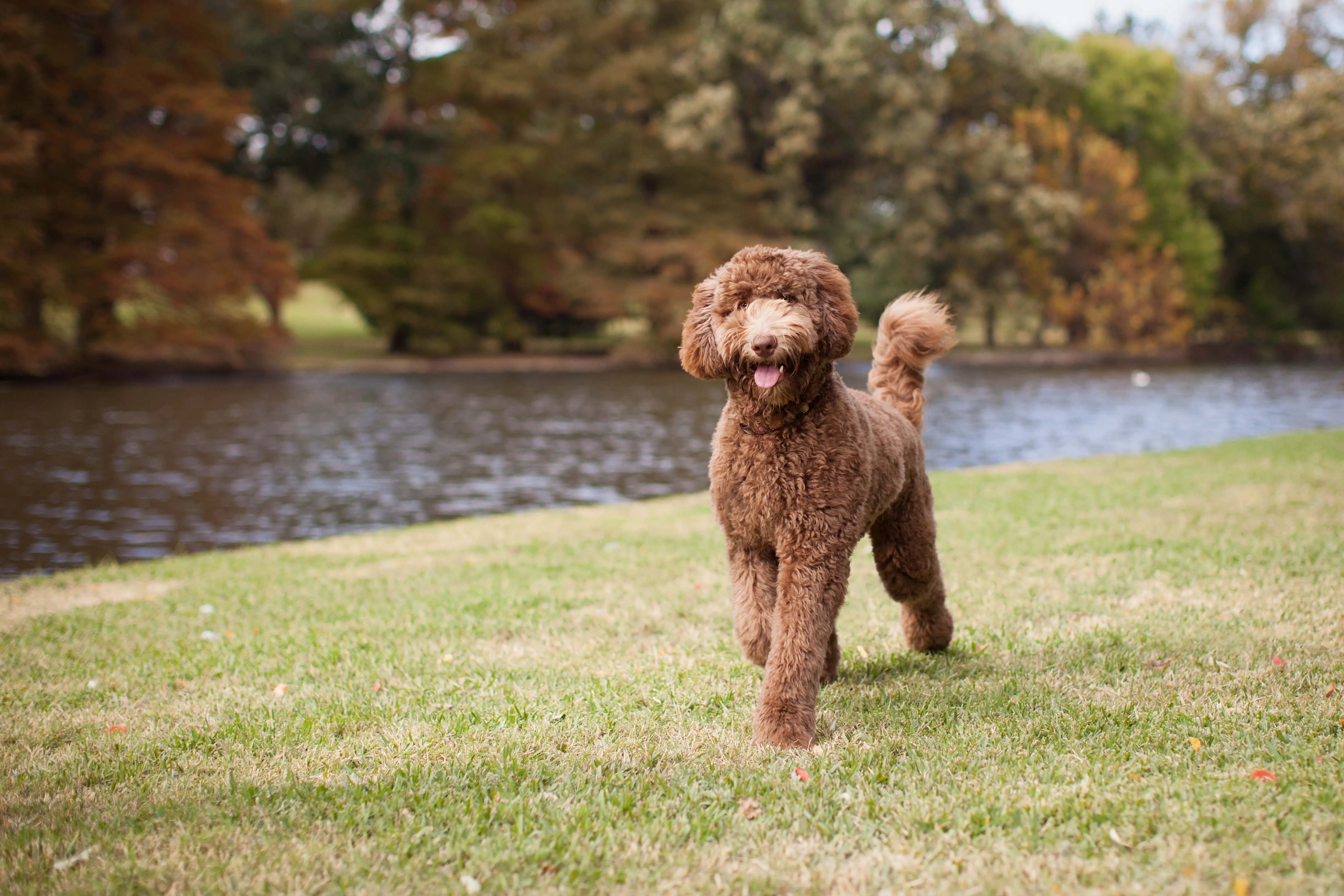 Brown Standard Labradoodle walking through a park on a sunny day
Brown Standard Labradoodle walking through a park on a sunny day
A cross between a Labrador Retriever and a Poodle, the Labradoodle was initially developed as a service dog for allergy sufferers. They inherit the Poodle’s low-shedding coat (though consistency can vary) and the intelligence and friendly nature of both parent breeds. Labradoodles make excellent family pets, known for their trainability and gentle disposition, particularly when well-socialized and exercised from a young age.
11. Goldendoodle
 Goldendoodle lying on a couch with a person's legs in the background, creating a cozy scene
Goldendoodle lying on a couch with a person's legs in the background, creating a cozy scene
Another popular “doodle” breed, Goldendoodles are a cross between a Golden Retriever and a Poodle. Like Labradoodles, they typically shed minimally and possess a friendly, intelligent nature. While many exhibit a golden coat from their Retriever heritage, their colors and coat textures can vary. Frequent grooming with a slicker brush is essential to prevent their often wavy or curly coats from matting.
12. Lagotto Romagnolo
 Two Lagotto Romagnolo dogs lying in dirt, intently staring at the camera
Two Lagotto Romagnolo dogs lying in dirt, intently staring at the camera
Lagotto Romagnolo dogs, often referred to as Lagotti Romagnoli in the plural, were originally water retrievers, with their dense, woolly, curly coats protecting them from cold waters. This coat type is low-shedding, making them a good option for allergy-conscious families. Though less common, they are known to be good with children and other pets, making them adaptable family dogs.
13. Affenpinscher
 Close-up of a black Affenpinscher dog's face, showing its unique, monkey-like expression
Close-up of a black Affenpinscher dog's face, showing its unique, monkey-like expression
Affenpinschers are small, distinctive dogs known for their “monkey-like” facial expressions. Their dense, wiry coats produce fewer allergens compared to many other breeds. However, this unique coat requires considerable care, including regular at-home brushing and a specialized grooming technique called stripping, which involves removing hair by the root rather than trimming it.
14. Irish Water Spaniel
 Profile shot of a brown Irish Water Spaniel with its curly coat, looking alert
Profile shot of a brown Irish Water Spaniel with its curly coat, looking alert
Friendly, intelligent, and highly trainable, the Irish Water Spaniel is another water-loving breed with a low-shedding, thick, curly coat that requires regular grooming. Their coat is always a rich liver (brown) color. These energetic dogs need plenty of exercise to stay happy and healthy, reflecting their background as retrieving game dogs.
15. Aussiedoodle
 Standard Aussiedoodle dog standing on a beach, enjoying the outdoors
Standard Aussiedoodle dog standing on a beach, enjoying the outdoors
An Aussiedoodle is a cross between an Australian Shepherd and a Standard or Miniature Poodle, inheriting intelligence and high energy from both parents. These low-shedding dogs are very smart but can become destructive if bored. Ample exercise and mental stimulation, perhaps with enrichment toys like dog treat dispensers, are crucial to keep them content and well-behaved.
16. Bolognese
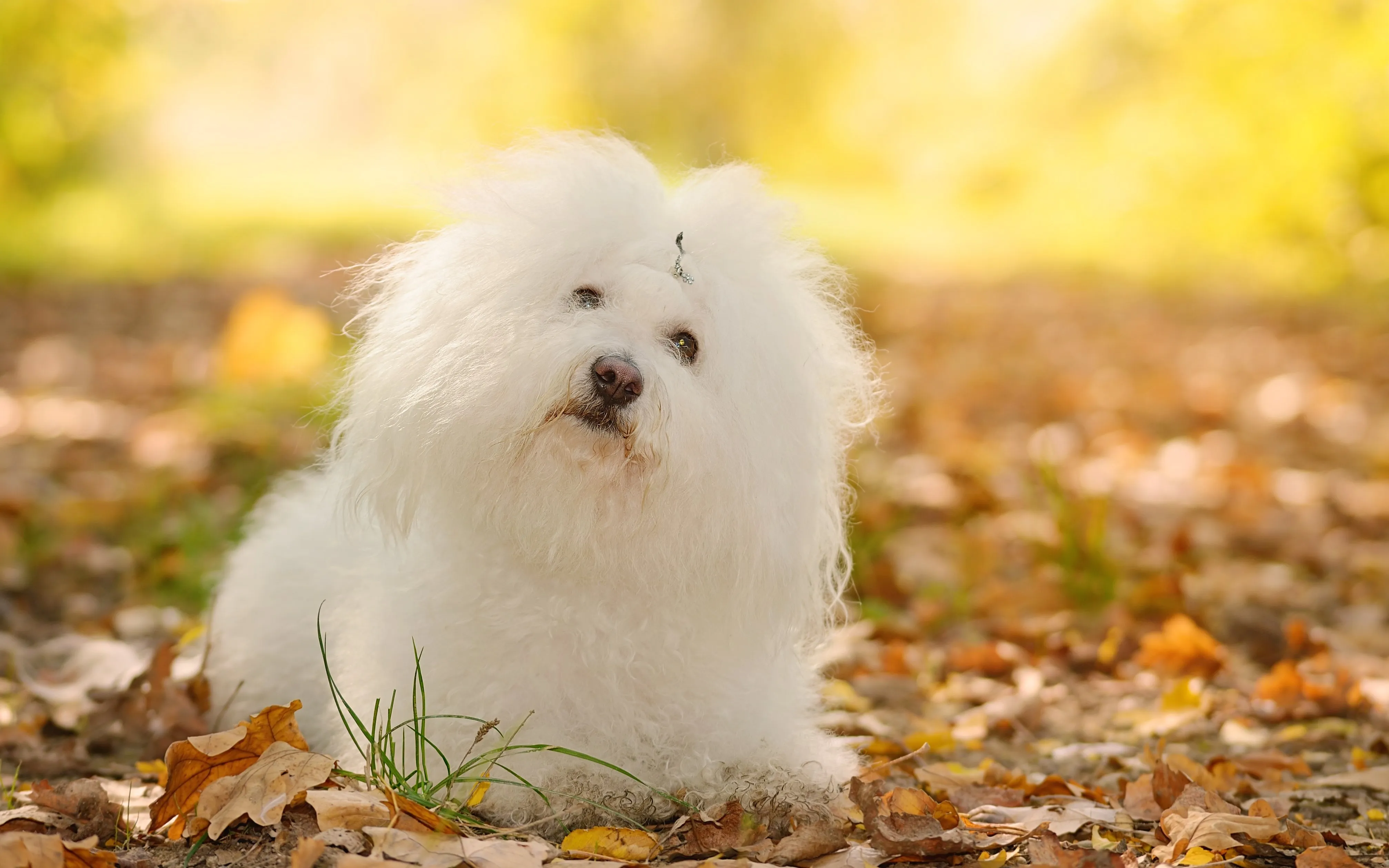 White Bolognese dog sitting attentively in an autumn forest setting
White Bolognese dog sitting attentively in an autumn forest setting
Originating in Italy, the Bolognese is an adorable small quiet dog breeds that don’t shed. They possess a long, fluffy white coat that, despite its characteristic messy appearance, requires diligent grooming. These playful and easygoing pups are known for their harmonious relationships with children and other pets, making them versatile companions for various living situations.
17. Maltese
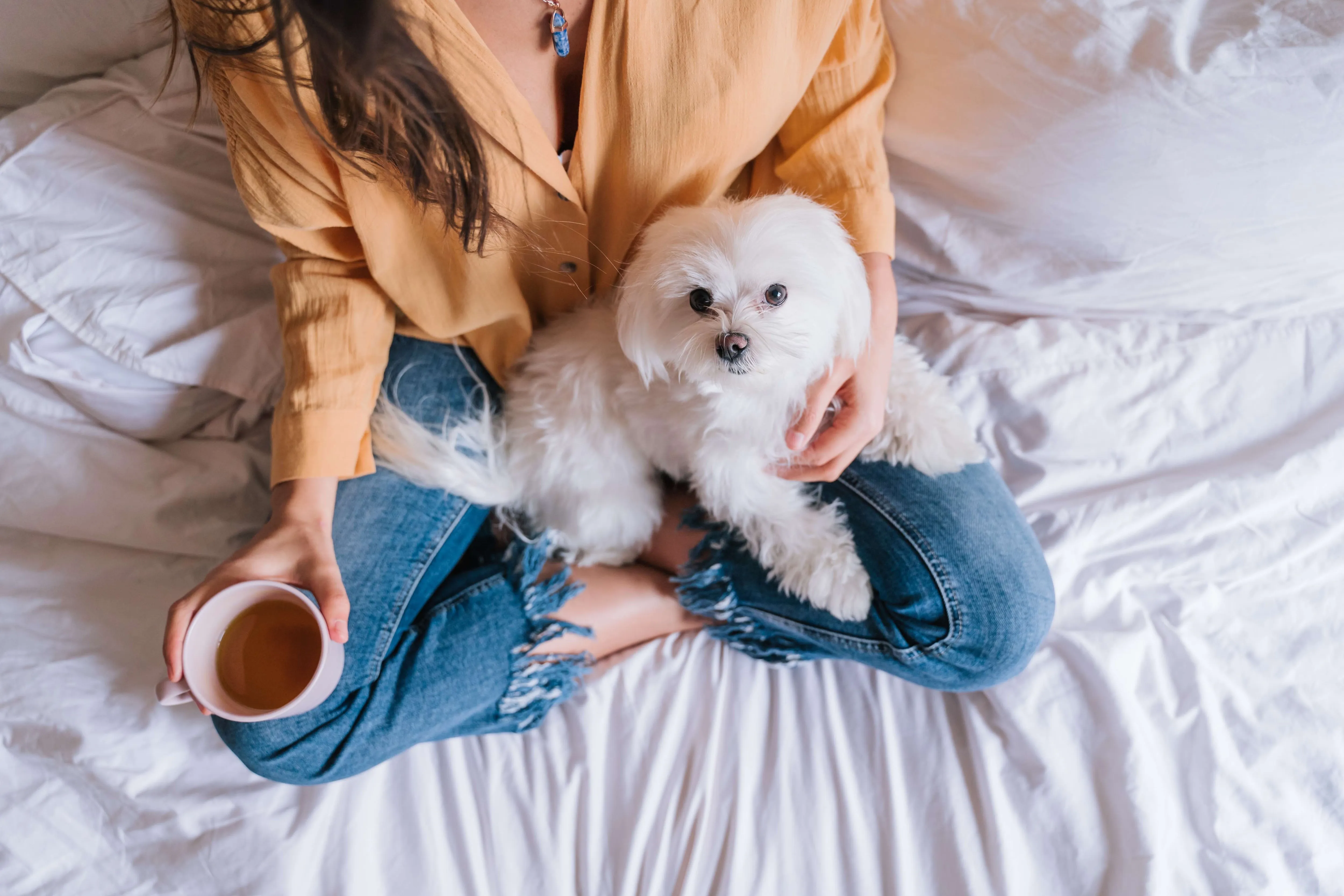 Woman gently holding a white Maltese dog on a bed, showing its luxurious coat
Woman gently holding a white Maltese dog on a bed, showing its luxurious coat
Another exquisite small, low-shedding dog, the Maltese is celebrated for its luxurious, silky white coat. Maltese dogs are affectionate and playful companions, ideal for pet parents who are committed to their significant grooming needs. For easier maintenance, many owners opt for a shorter “puppy cut” using dog hair grooming clippers.
18. Soft Coated Wheaten Terrier
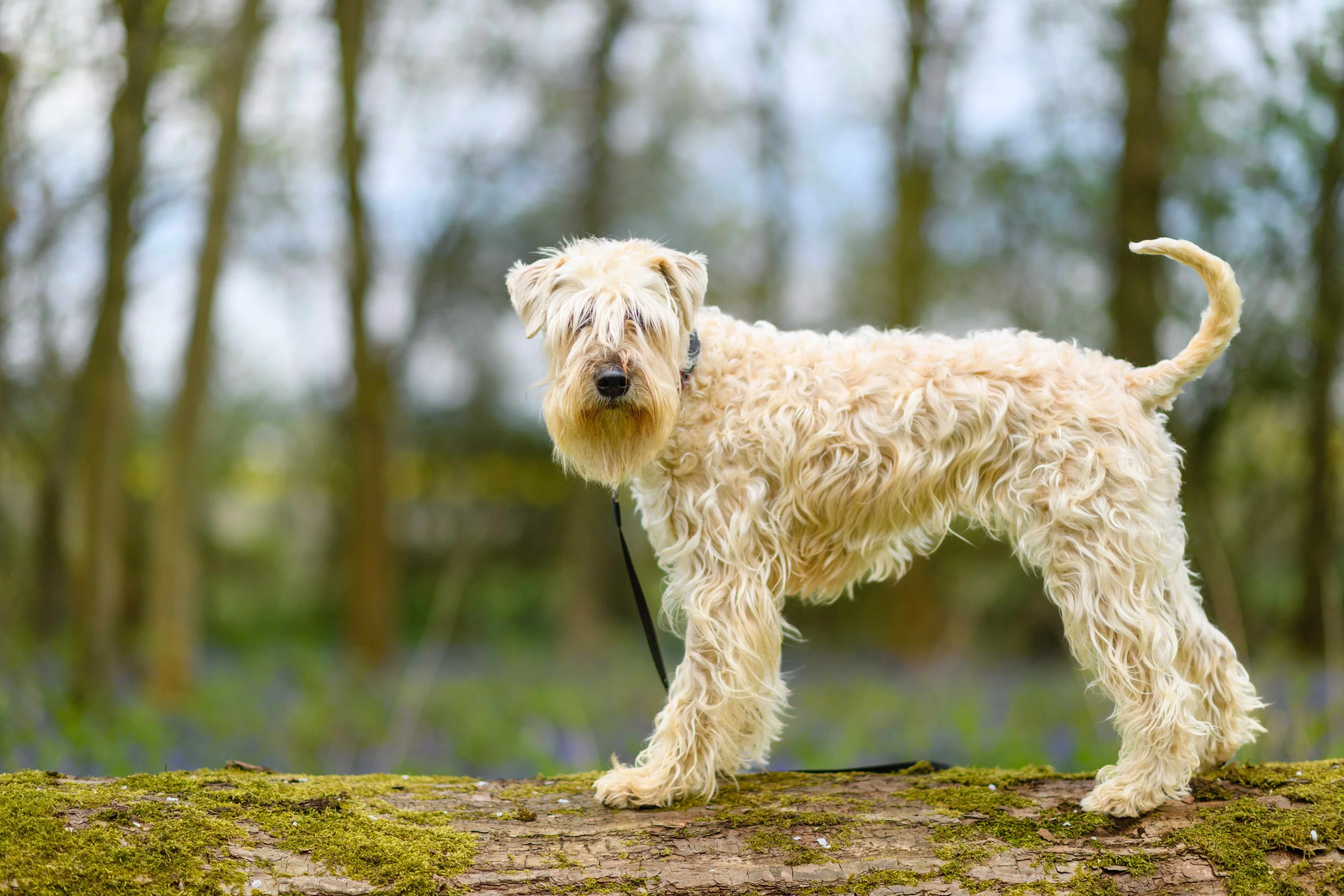 Soft Coated Wheaten Terrier dog perched on a log, looking content in a natural setting
Soft Coated Wheaten Terrier dog perched on a log, looking content in a natural setting
The Soft Coated Wheaten Terrier is a medium-sized Irish breed known for its incredibly soft, silky coat that sheds minimally. True to their terrier heritage, Wheatens possess a high energy level throughout their lives, necessitating abundant exercise and mental stimulation to ensure their well-being and good behavior.
19. Coton de Tulear
 White Coton de Tulear sitting in grass with its hair gently blowing in the wind
White Coton de Tulear sitting in grass with its hair gently blowing in the wind
Hailing from Madagascar, the Coton de Tulear is a small, easygoing breed with a soft, cotton-like coat that sheds very little. Their amiable nature makes them an excellent fit for families with children and other pets, especially when proper introductions are carefully managed.
20. Schnoodle
 Close-up of a gray Schnoodle dog's face, displaying its wavy coat and expressive eyes
Close-up of a gray Schnoodle dog's face, displaying its wavy coat and expressive eyes
The Schnoodle is a designer breed resulting from crossing two low-shedding breeds: the Schnauzer and the Poodle. Their coat can be curly or wavy, depending on genetic inheritance, but is consistently low-shedding. This combination often results in a smart, playful, and loyal companion.
21. Bedlington Terrier
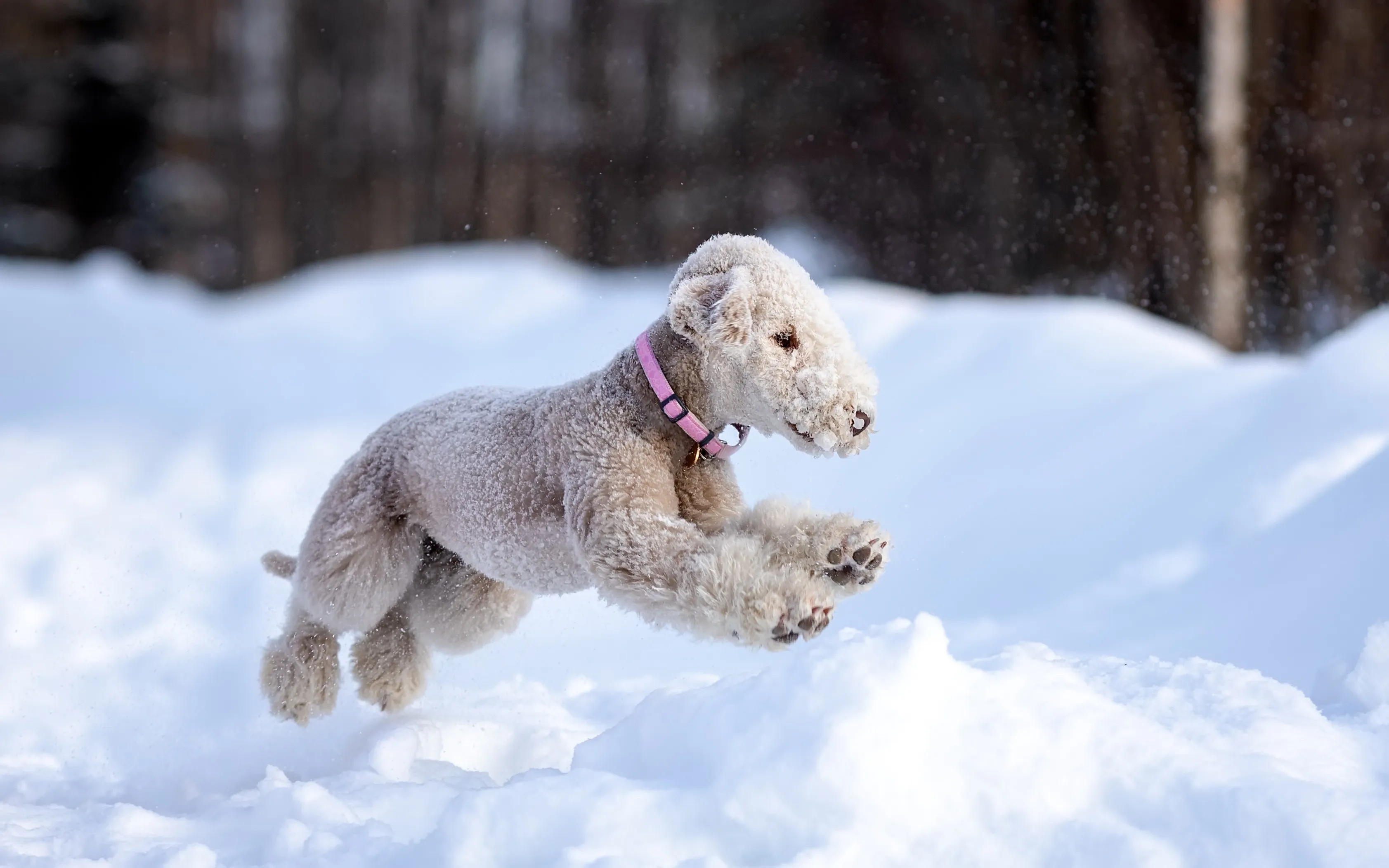 White Bedlington Terrier running gracefully through a snowy landscape
White Bedlington Terrier running gracefully through a snowy landscape
Often described as “a lamb in dog’s clothing,” the Bedlington Terrier is a small, curly-haired breed distinguished by its unique topknot and pom-pom ear tufts. These dogs are deeply devoted to their families but can be prone to separation anxiety if left alone for extended periods. Monitoring their activity with a dog camera can help manage and address such behavioral concerns.
22. Xoloitzcuintli
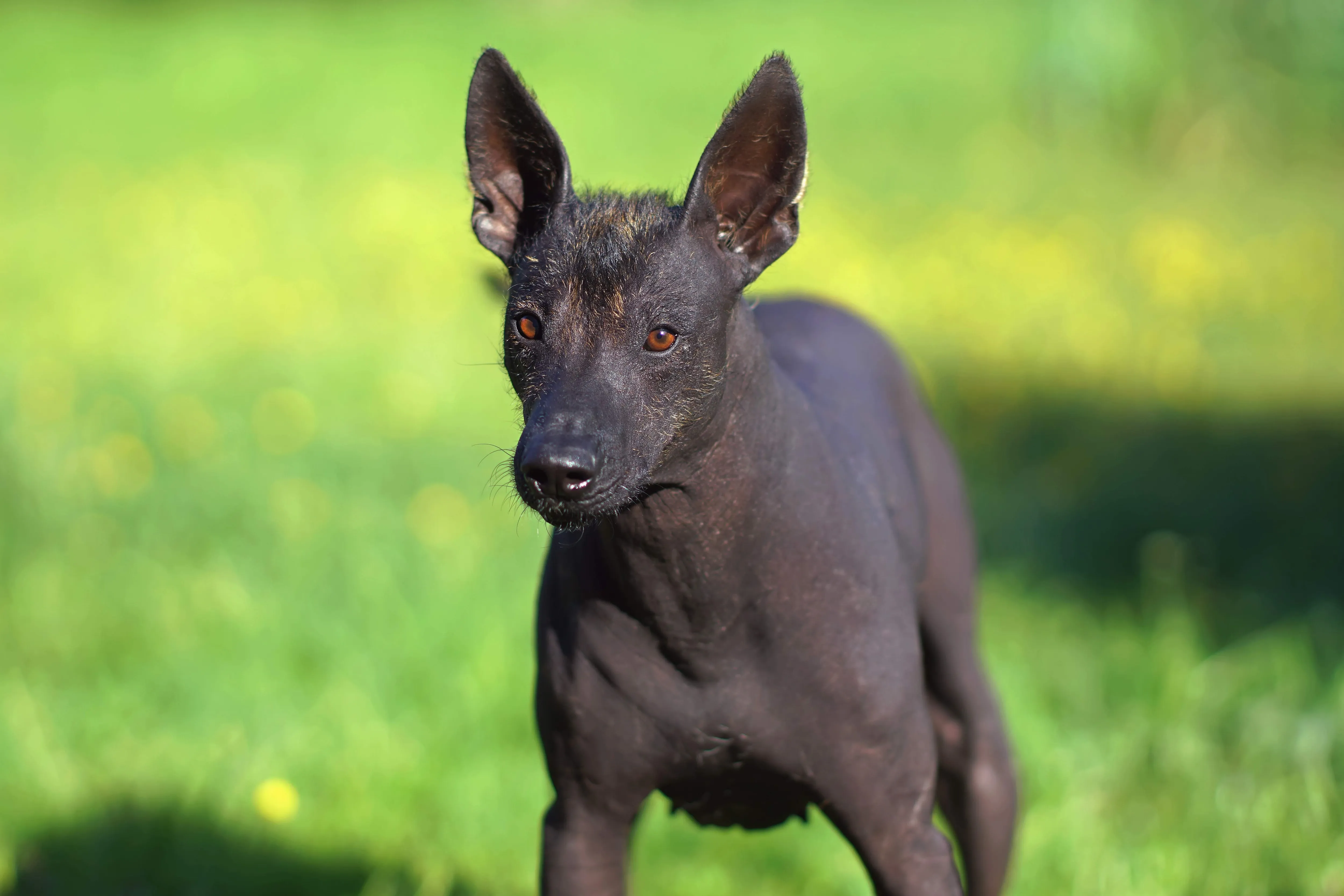 Black Mexican Hairless Dog (Xoloitzcuintli) standing alertly in lush green grass
Black Mexican Hairless Dog (Xoloitzcuintli) standing alertly in lush green grass
The Xoloitzcuintli, or Mexican Hairless Dog, is one of the world’s oldest and rarest breeds. Available in toy, miniature, and standard sizes, they come in hairless and coated varieties. Both types are considered low-shedding, with the hairless version being particularly suited for those with allergies due to the absence of a fur coat.
23. Whoodle
 Tan Whoodle puppy playfully dragging a washcloth across a floor
Tan Whoodle puppy playfully dragging a washcloth across a floor
A Whoodle is a delightful cross between a Soft-Coated Wheaten Terrier and a Poodle. These friendly dogs inherit the low-shedding qualities of both parent breeds, ensuring a minimal impact on allergy sufferers. They are also known for their intelligence and affectionate nature, making them engaging and loving family members.
24. Bernedoodle
 Large Bernedoodle dog lying in grass with its tongue out, looking happy and relaxed
Large Bernedoodle dog lying in grass with its tongue out, looking happy and relaxed
Bernedoodles are a crossbreed resulting from the combination of Bernese Mountain Dogs and Poodles. Their friendly, affectionate nature and gentle demeanor make these large low-shedding dogs a popular choice for families, especially those with children and other pets. However, their size and energy mean they require plenty of exercise and mental stimulation to stay healthy and content.
25. Shorkie
 Tricolor Shih Tzu and Yorkshire Terrier mix (Shorkie) sitting on a hiking trail
Tricolor Shih Tzu and Yorkshire Terrier mix (Shorkie) sitting on a hiking trail
The Shorkie is a charming mixed breed created from a Shih Tzu and a Yorkshire Terrier, combining the best traits of two low-shedding breeds. These small dogs are playful, friendly, and adapt well to various home environments. Like many breeds on this list, a consistent and dedicated grooming routine is essential to maintain their coats. Considering different small short haired dogs that don’t shed might also broaden your choices.
26. Afghan Hound
 Gray and tan Afghan Hound looking directly at the camera, showcasing its long, flowing coat
Gray and tan Afghan Hound looking directly at the camera, showcasing its long, flowing coat
Afghan Hounds are striking dogs known for their long, flowing coats and elegant, slender builds. Despite their abundant hair, they are considered low-shedding and require extensive grooming. Built for speed, they are one of the fastest dog breeds. While loving toward their families, they can be aloof with strangers, making early and consistent socialization critical for this unique breed.
27. Barbet
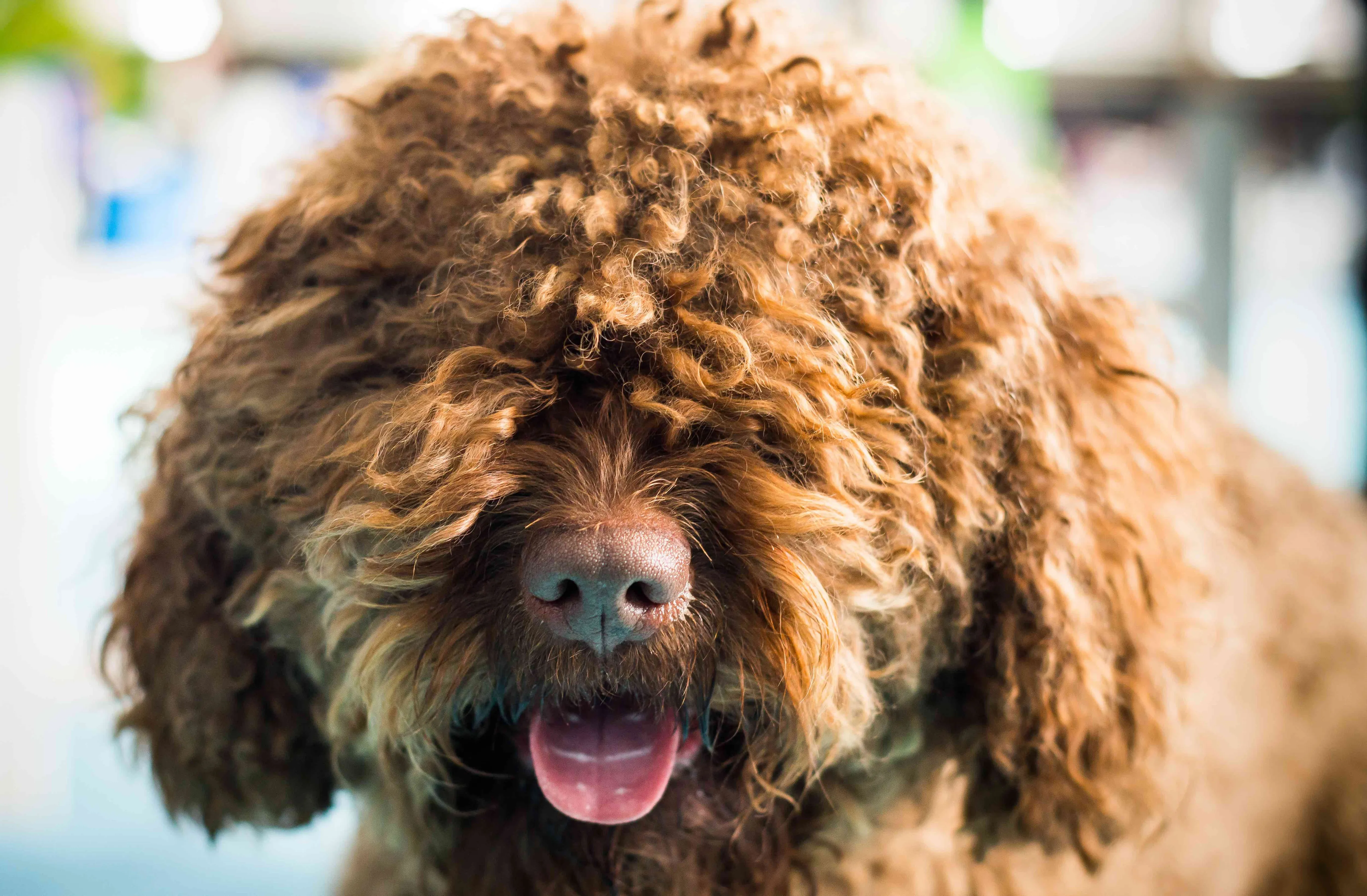 Close-up of a curly red Barbet dog's face, highlighting its shaggy, woolly coat and beard
Close-up of a curly red Barbet dog's face, highlighting its shaggy, woolly coat and beard
The Barbet, pronounced “bar-bay,” is a cheerful pup with a shaggy, woolly coat. Its name, derived from the French word barbe (beard), perfectly describes its characteristic hairy chin. This large, low-shedding dog loves to swim, a trait facilitated by its protective curly coat. Regular brushing with a slicker or pin brush, two to three times a week, is essential to keep its coat in prime condition, especially after water activities.
28. Shih-Poo
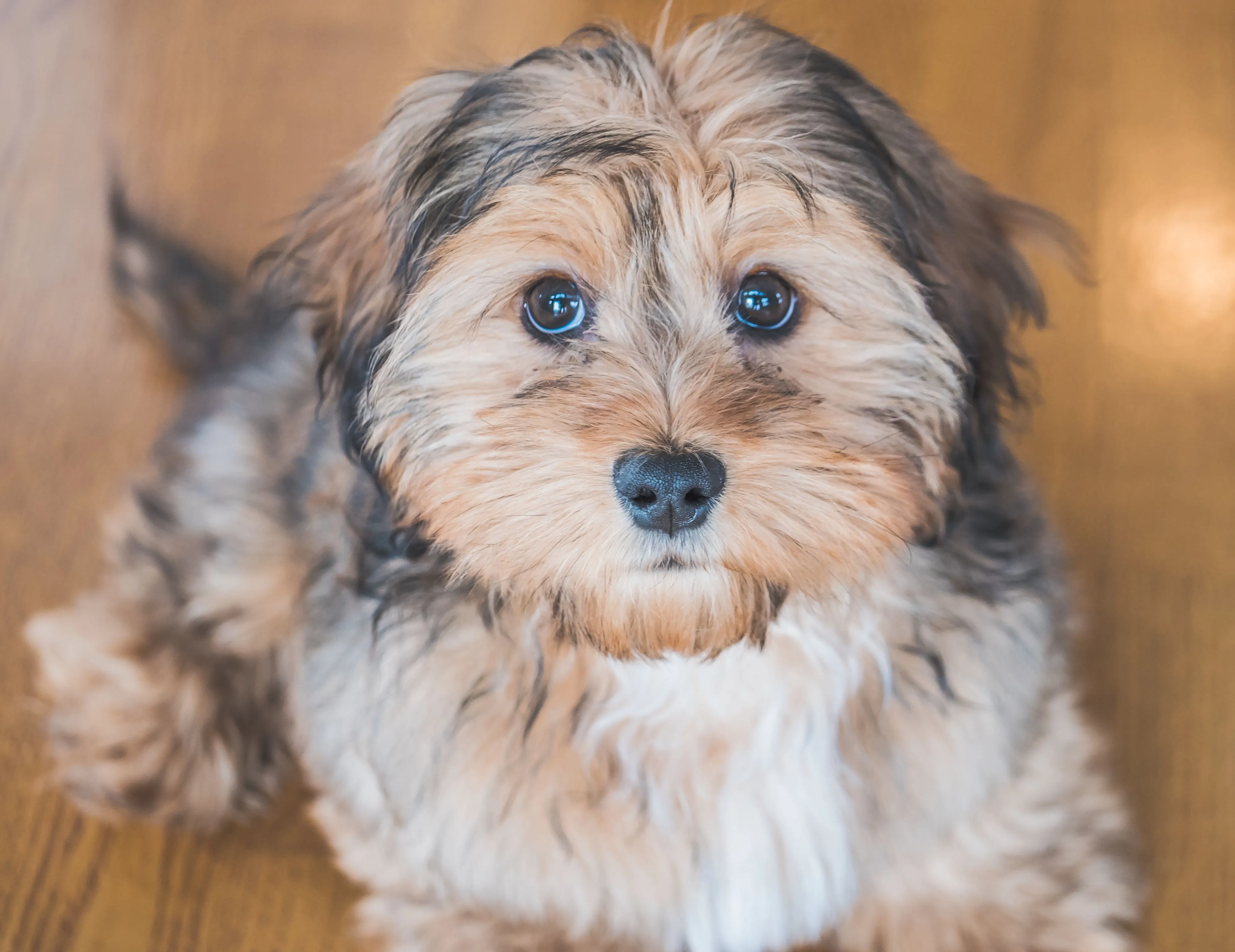 Close-up of a tan and black Shih-Poo dog's face, showing its soft, wavy fur
Close-up of a tan and black Shih-Poo dog's face, showing its soft, wavy fur
The Shih-Poo is a mixed breed resulting from a cross between a Shih Tzu and a Poodle (most commonly a Toy Poodle). This small, low-shedding pup adapts well to nearly any living situation, provided it receives around 30 minutes of daily exercise and a good brushing session to keep its coat healthy and tangle-free.
29. Peruvian Inca Orchid
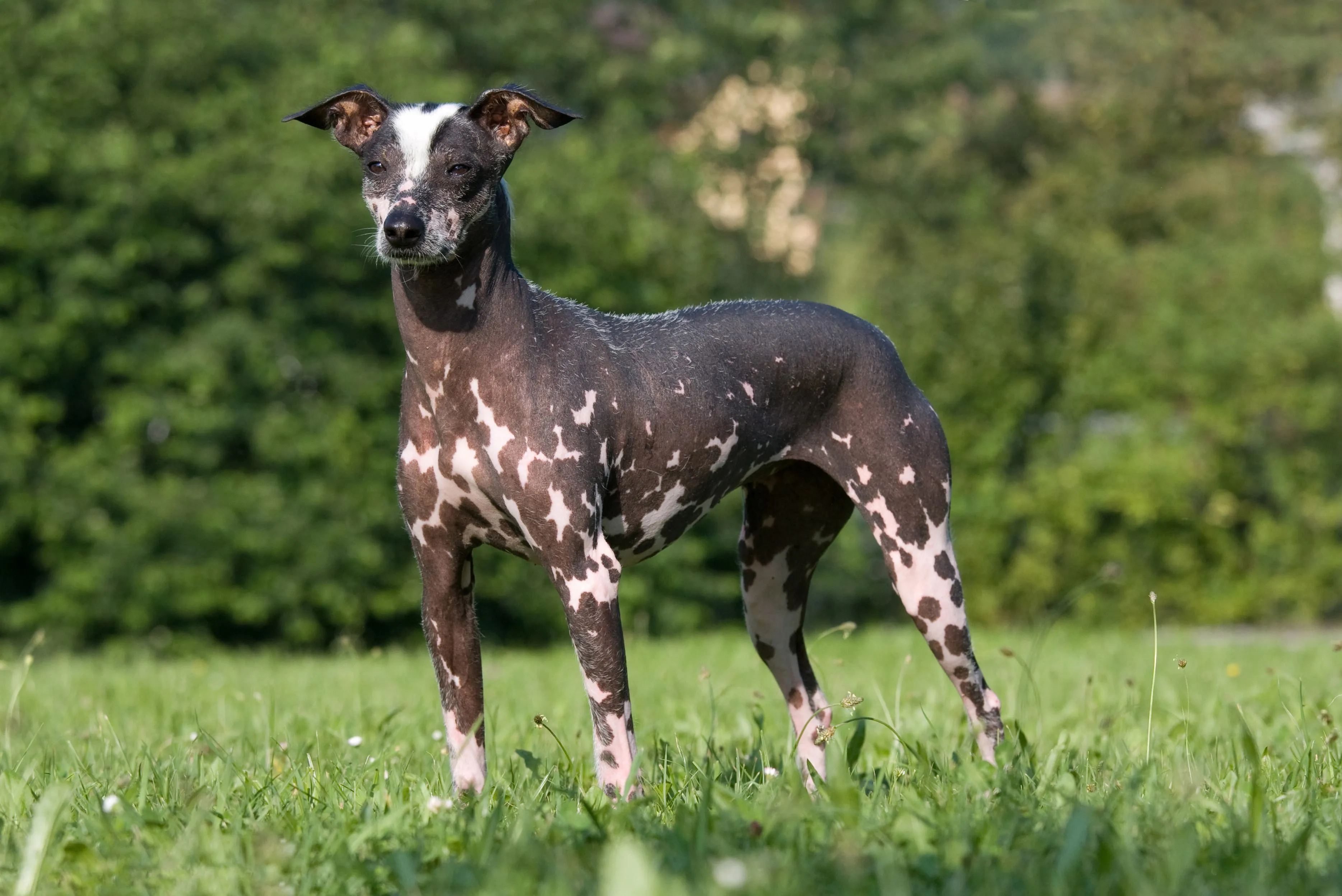 Peruvian Inca Orchid dog, a hairless breed, standing gracefully outdoors
Peruvian Inca Orchid dog, a hairless breed, standing gracefully outdoors
The Peruvian Inca Orchid, though rare, is a truly low-shedding dog due to its mostly hairless body. This ancient breed, the national dog of Peru, comes in small, medium, and large sizes. Their unique appearance and minimal dander production make them an intriguing option for allergy sufferers. Exploring various types of dog breeds can open up many possibilities for potential pet parents.
30. Malshi
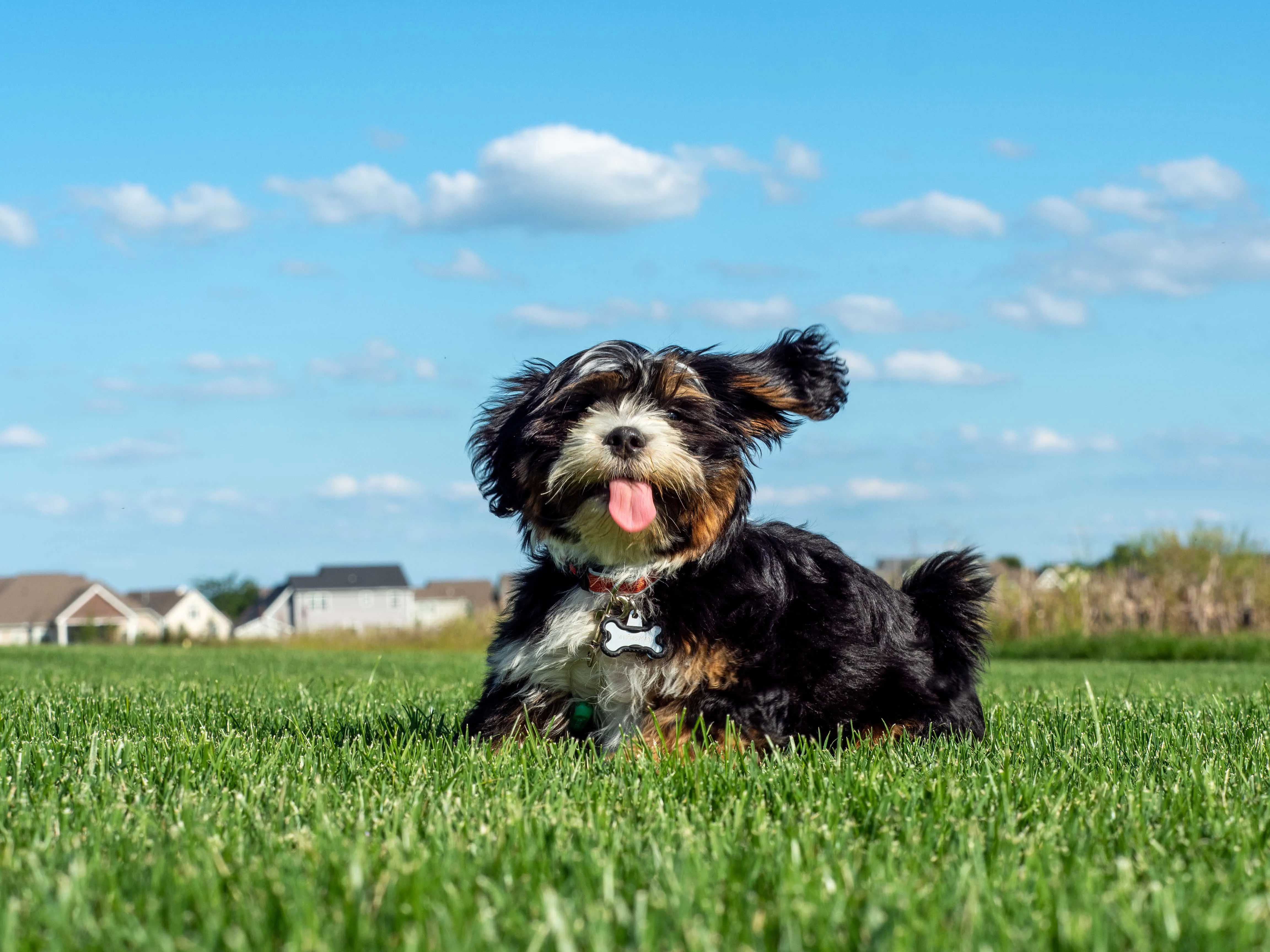 Tricolor Malshi dog sitting contentedly in green grass
Tricolor Malshi dog sitting contentedly in green grass
As a cross between the Maltese and Shih Tzu, the Malshi is a happy, small, low-shedding dog. They thrive on close companionship and are most content when their favorite humans are near. Their affectionate nature and minimal shedding make them an ideal choice for families seeking a cuddly, allergy-friendly pet.
Essential Tips for Living with a Low-Shedding Dog
Bringing home a dog that doesn’t shed much is a fantastic step towards an allergy-friendly household, but it’s not the only consideration. Here are crucial tips for managing allergens and ensuring a harmonious home environment:
Consistent Grooming is Key
Even low-shedding dogs require diligent care and maintenance to minimize allergens. Their coats, while not shedding profusely, can still trap dander. Regular grooming and bathing are paramount. Ideally, dogs should be groomed weekly, with bathing every four to six weeks. Utilizing specialized shampoos, such as dander-reducing formulas, can significantly help in managing pet allergens. Many of these breeds also need regular professional trimming or hand-stripping, which should be factored into your budget or learned for at-home care.
Maintain a Clean Home Environment
Minimizing allergens extends beyond your dog’s coat to your home itself. Regular vacuuming with a HEPA filter, dusting surfaces, and washing bedding frequently are essential practices to reduce accumulated pet dander. Employing air purifiers and ensuring good ventilation throughout your house can further reduce airborne allergens, creating a cleaner and more comfortable living space for everyone.
Consult Your Doctor and Veterinarian
For individuals with dog allergies, proactive management is vital. Always consult with your healthcare provider to discuss allergy treatment options, which may include medications, nasal sprays, or allergy injections. It’s also important to be mindful that allergens can be present in a dog’s saliva and urine, so avoiding direct contact with these bodily fluids is advisable. Your veterinarian can offer specific advice on diet, supplements, and grooming products that can contribute to your dog’s skin and coat health, further reducing dander.
Bringing a small house dog breeds that don’t shed into your life can dramatically improve the quality of life for individuals with allergies. These remarkable companions offer all the joy and affection of pet parenthood, allowing you to experience unconditional love with significantly fewer allergic reactions. With careful consideration, proper care, and a little planning, an allergy-friendly home with a beloved canine friend is entirely within reach.
WRITTEN BY
Nicole Zittritsch, LVT, BSc, MPH
Veterinarian Technician
